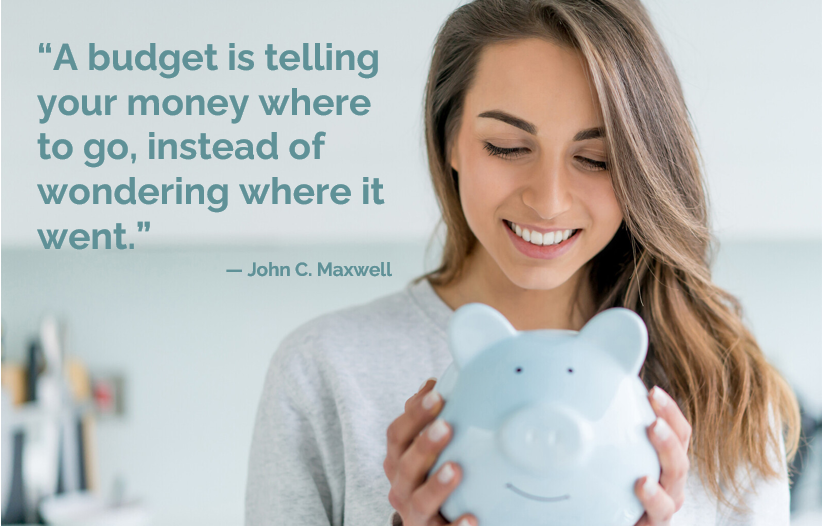Especially for younger or first-time homebuyers, the idea of saving up for a home may seem unthinkable. And if you’re someone who’s used to renting, it’s natural to take one look at a home listing with a 6+-figure price tag and go running the other way.
But the reality is, almost no one buys a home with bags of cash to cover the full price; as little as $6,000 in savings could suffice as a down payment on a $200,000 home, with a monthly mortgage payment that’s actually less than what you’re paying in rent now.
For more, check out our mortgage prequalification calculator.
Strategies To Help You Save For a House
If a down payment of any amount sounds like a stretch, stick with us. There are plenty of simple strategies you can employ to start putting money aside today, so that home ownership could be in reach much sooner than you think.
Strategy #1: Reduce Everyday Expenses

— John C. Maxwell
It’s a truism, but the little things really do add up. We’re not here to call you out on avocado toast, or to argue that you lead a joyless spartan existence now that you’re interested in home ownership, but you may find that cutting extra expenses here and there can make a bigger difference than you expected.
A great way to start with this is to download a free budgeting app – like Albert or Mint – to make sense of where all your money goes. You can see your funding divided by not only bills and subscriptions, but any number of spending categories. Let’s take a closer look at how to shave away your spending.
Are you really using all of those subscriptions? Did you even realize that you were paying for all of them? For the ones you do need, consider paying for a year instead of a month at a time; it might seem counterintuitive to pay more now, but an annual fee of $60 beats a year of $10 monthly payments any day.
Meals:Making food at home more often, and relying on restaurants and takeout less, is seemingly a no-brainer – but especially with rising prices, grocery bills for all those affordable home-cooked meals can be surprisingly high. If you find yourself throwing away a lot of produce you don’t have time to use, grab some reusable green bags that can keep it fresh for longer, and plan out your meals a week at a time, so that you only buy as much food as you need.
Entertainment:If you’re the cultured type, you don’t need to sit things out. Do a little digging into free concerts and other entertainment options – and when you do have your heart set on something with a price tag, see if you can be flexible and go for cheap rush tickets. If you’re meeting up with friends, try switching out dinner and drinks for a budget-friendly happy hour and dinner at home. In a city like New York, little tweaks like these could save you $100+ over the course of one night, while also ensuring that you’re not missing out on all the fun.
Online shopping:If you struggle with impulse shopping (as so many of us do these days), try installing a browser extension – often marketed as productivity aids — that blocks access to any website(s) you choose. (And when you do make purchases, consider adding a plugin like Honey or RetailMeNot that will automatically find and test promo codes at checkout, or Rakuten, which gives you back a percentage on your purchases.) If you find yourself clicking through to online sales and buying things you don’t need, consider removing yourself from some promotional mailing lists.
Clothing:If you have clothes you’re not wearing, you can try consigning them, or bringing them by a thrift store to see if you can trade them in for new threads rather than buy more brand-new clothes; as an added plus, many thrift stores will donate or sustainably recycle any clothes they don’t accept. In addition to old stand-bys like Craigslist, sites like Freecycle, Trash Nothing!, Buy/Sell/Trade, or your local Buy Nothing group (typically on Facebook) can also be great resources to get and give clothes and other items in great condition.
Strategy #2: Put larger expenses on hold
Not everyone has the option to go on vacation, but if you do have that privilege, you might want to consider skipping it, cutting it short, or going somewhere more affordable closer to home. There’s also no underestimating flexibility: If you can go on vacation in October instead of July, you could find yourself saving a bundle without having to stay home.
If you were thinking of getting a new car, new furniture, or another major purchase, consider whether you can make do with what you have. And if you really can’t, look into used options, which can often still be in great condition; as we mentioned above, members of local Buy Nothing groups are often happy to give away high-quality items for free.
Strategy #3: Automate and Maximize Savings:
If you struggle to put money aside, there’s an app for that (actually, there are a bunch of them). Apps like Qapital, Chime, and Digit can round up purchases to the nearest dollar and set the difference in a separate account, or deduct a certain amount from every paycheck. Others, like Acorn or Ellevest, can take those funds and automatically invest them for you. If you have the discipline to just let the apps do their thing (a good tip for this can be to sign up and then delete the app from your phone, so you don’t know exactly what’s accruing), you may find yourself checking in one day and finding that you’ve saved a few hundred dollars – or more – without even noticing. You can also likely set up a recurring direct deposit – and remember, no amount is too small! – into a savings account directly through your bank.
If you’re currently saving for retirement (and you should) but find yourself on a real time crunch for a down payment, you could also consider diverting some of those savings into your down payment fund – but this strategy isn’t to be taken lightly. It’s easy for temporary spending patterns to become permanent, and you don’t want to find down the road that you never switched back to saving for retirement, and now all your savings have gone into your home.
Wherever they’re coming from, don’t let your savings just sit there. Transfer your extra cash into a high-yield savings account, so that the money grows without you lifting a finger.
Strategy #4: Increase Your Income
This seems obvious, but bears some real time and thought. It’s easy to let time go by without thinking to ask for a raise or promotion, but saving for a down payment can be a great motivator. If you want to help make your case, consider taking a professional development class (which many employers will reimburse you for) or pick up some new skills, to make a case to your manager that you merit higher compensation.
If you find yourself in a job where neither a raise or promotion are possible, or you’ve hit your professional ceiling in any other sense, it could be time to start looking around for more lucrative employment opportunities elsewhere. Just keep in mind that when it comes to mortgage applications, most lenders like to see a steady employment history within the same field, so you likely won’t want to apply for a mortgage soon after starting a new job, let alone a new career.
In the current gig economy, there’s also no shortage of opportunities to make some cash on the side. Do you have skills as a writer, coder, tutor, or editor that you could market? What about pet-sitting, or dog-walking? You can even look into market research companies that will pay you to answer surveys, or to submit reports on website user experiences.
Strategy #5: Ask for Help
Again, not everyone has this luxury. But if you do find yourself able to ask friends and family for contributions to your down payment – say, in lieu of birthday or wedding gifts – there’s certainly no shame in asking. (That said, many lenders will require extra paperwork from any borrower using gifts towards a down payment, indicating that the giver had the financial ability to make the gift, among other things.)
Crowdfunding from loved ones is an increasingly common way to pull together money for your first home, and it certainly beats getting your fourth or fifth toaster.
Strategy #6: Downsize
It’s always worth looking at your current living situation. If you live in a high-price city like New York, this might seem like a silly question, but do you need as much space as you have? If you do, could you move to a less central area, or even another city altogether? (Of course, it’s important to remember that moving itself brings its own costs, so you’d need to be saving enough money in rent to offset that expense.) It’s up to you to decide what your priorities are – but especially if you were considering a move anyway, it could be worth asking if you’d like to do so sooner rather than later, and start saving now with a lower cost of living.
Strategy #7: Consolidate Existing Debt
Taking a cold, hard look at any existing debt isn’t fun, but it can really pay off (pun very much intended). If you have student loan payments, car payments, multiple credit card payments, or any other form of debt, take a look at all of it and see what you’re paying in interest.
You may find that if you refinance certain loans, pay off the credit cards with the smallest limits first, move the rest of your debt onto lower-interest credit cards, take out a debt-consolidation personal loan, apply for credit limit increases (without spending more once you receive them!), or all of the above, you can not only save yourself a lot in monthly interest, but also boost your credit score and lower your debt-to-income (DTI) ratio, all of which will prove invaluable when it’s time to get prequalified for a mortgage. If it all seems overwhelming, consider speaking with a financial advisor, who’ll be happy to help.
How Much Should I Save Before Buying a House?
Conventional wisdom has long dictated that you should have 20% on hand for a down payment. And while it would certainly be nice to have that amount to contribute, it’s far from a necessity; these days many conventional mortgages require as little as 3% down, especially if you have good credit – or even no down payment at all.
Loans backed by the Federal Housing Administration (FHA), which are designed to put home ownership in reach of low- and middle-income borrowers, can require as little as 3.5% down. Other government-backed loans require no down payment at all – including US Department of Agriculture (USDA) loans, which are put aside for borrowers who’d like to live in rural areas (though “rural” in this context only refers to population limits, and many towns and suburbs can qualify). VA loans, backed by the Department of Veterans Affairs, also require no down payment; these are reserved for active or former members of the US military, and their spouses.
For info on all this and more, see our blog post on types of home loans.
You will want to be aware, though, that putting anything less than 20% down will likely trigger private mortgage insurance (PMI), which ranges from 0.3%-1.5% of the loan value, and is wrapped into your monthly payment. (As a fun fact, the PMI threshold is actually where the 20% down payment idea originally came from.) Once you’ve paid 20% of the principal of your home’s equity, PMI will typically no longer be charged, though some loans (like FHA loans) do charge PMI for the lifetime of the loan.
And in case you were wondering: While you technically can apply for a personal loan to fund your down payment, there’s a fairly narrow range of options for that tactic, and it may make it harder to get a mortgage; the likelihood is that most lenders won’t be eager to approve borrowers applying for a loan on top of a loan. After all, Proof of Funds is an important part of any mortgage application, and no matter what, it’s always best to bring as much of your own cash as possible to the table.
How Long Does It Take To Save Up For a House?
There’s no set answer as to how long it takes to save up for a house. It depends almost entirely on your circumstances, including how soon you’d like to become a homeowner.
Intuit Mint calculated in 2020 that it takes 4.25 years for the average American household to save for a $54,145 down payment (the national average for a 20% down payment).

Of course, if you’re planning to buy a home with a 3% down payment, that could mean having the funds available in less than a year – though this varies hugely depending not only on personal lifestyle factors, but on where you live. In areas with a high cost of living and high property prices, it can take much longer; for instance, Intuit Mint estimates that in Hawaii, it takes 9 years to save up for a 20% down payment.
As we’ve discussed above, there are certainly strategies to fast-track your savings. But as a general rule of thumb, the more time you can spend saving, the better – just for one thing, it can help you save in the long term, since you don’t have to pay interest on money you haven’t borrowed.
And as you’ve likely already heard, a home is the largest purchase many of us ever make, so you don’t want to rush into that kind of purchase. You could find not only that you haven’t chosen the best home for you, but that you could have saved a bundle on your mortgage with a bit more planning.
Common Questions About Saving For a House
As you start saving for a house, you’ll find yourself constantly asking new questions, but here are some of the most common to start with.
All in All – Buying a Home Requires a Lot of Planning
The common thread of all of this is that buying a home requires a lot of planning. After all, if you have boxes of books to move, you’ll want to have your bookcases assembled before your books arrive, and you’ll want to have your walls painted before your bookcases are assembled, and you’ll want to make sure you love the paint color before you paint the walls…and so on.
All of this might seem overwhelming, but just remember that it can all be broken into steps. You might find that, as with the above example, the easiest way is to work backwards, until you reach a point where there’s nothing else that needs to be done before you can get started. And actually, now that you’ve read this post, that’s Step #1 already checked off.
*Mentions of third-party websites and tools are for illustrative purposes only, and does not constitute an endorsement or guarantee from K. Hovnanian Homes. Please use at your own discretion.
Last Updated on October 24, 2025
